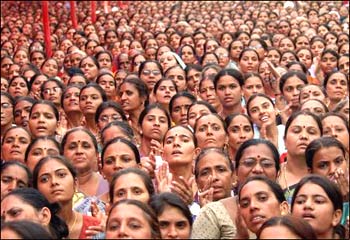Krutisheel women of Swadhyay Pariwar celebrate Purushottam Maas
Pujya Dada has rejuvenated a number of great cultural traditions, festivals, and cultural symbols. Due to Rev. Dadaji's tireless efforts, these elements of culture have acquired their original, and in some cases, new contemporary meanings.

The latest addition to this glorious tradition is that of the celebration of the holy Purushottam maas (adhik maas or month). With its all-too-familiar purely ritualistic celebration, which has been devoid of spirit and has been incapable of satisfying the intellectual curiosity of the modern day youth, the eons-old Indian tradition has been losing its luster.
However, the Swadhyay Pariwar has given a new meaning and a "new" interpretation & spirit to the Purushottam maas; it is new when compared to what has been happening in the society at large. The "new spirit" essentially translates into the "original spirit" of this grand tradition. This "new" way is a bold break from the past, i.e. the past as it exists in the living memory. It, in fact, strives to bring back the ancient, original spirit. This year, Pujya Didiji suggested the following way of celebrating Purushottam maas.
For thirty-nine days, the krutisheel ladies of the Swadhyay Pariwar would visit families of their respective "1+2+20" groups (families of the Vimshati kendras). Typically during their daily visits, each lasting an hour or so, they would be able to visit one or two families. Each visit would commence by offering Tulsi-Patra to the sacred Bhagavad-Gita, after which they would recite the Trikal Sandhya, Krushnashtakam, and a Bhavgeet. This would be followed by a short speech ("chintanika") lasting ten minutes. Additionally, on each Monday of this 39-day period, these families would meet at the nearest Yogeshwar Krushi where, in addition to the above, all would recite the 13th chapter of the Bhagavad-Gita and engage in leisurely games.
This nation-wide activity has led to heartening results. A large number of ladies hitherto unexposed to Swadhyay have developed a new love for these thoughts. The ladies came closer to each other and Swadhyay work experienced rejuvenation in areas where it was otherwise nascent.
Numerically, the response has been truly astounding. Even in big cities like Mumbai and Ahmedabad, this activity has witnessed a large-scale participation, surpassing all expectations.
Didiji, before and during the course of this Purushottam maas, addressed participating krutisheel ladies. In the Saurashtra area, she addressed 80,000 women, 60,000 in the Ahmedabad area, and 80,000 krutisheel women in Baroda. Similarly, from the seven districts around Aurangabad, 11,000 women participated.
In each of these meetings, Didiji touched on the theme of womanhood, what it really means, and why women are better suited to live a cultured and elevated life. She gave a comparative overview of the treatment meted out to women in the Western and other civilizations, and the views of the Indian thought and Indian (Vedic) tradition.
In Saurashtra, at a meeting held in Moraj, Didiji especially dedicated a major part of her address to the Kshatriya women. As unbelievable as it may sound in the 21st century, most Kshatriya women are not allowed to leave their residences! Once they enter their married homes, they spend their entire lives within the confines of these homes! This is true for hundreds of thousands of Kshatriya women. Defying this tradition, almost 15,000 of these Kshatriya women participated in this meeting. Didiji reminded these women of the central role played by the Kshatriyas in the protection of culture and civilization. Interestingly, the organization of this meeting was almost entirely in the hands of the women.
By all accounts, the participation of Kshatriya women is unparalleled and reflective of what the Swadhyay spirit and constructive work has done for the cause of women across the regions.
"Tav chaha parinam hoga Dadaji".